FIAT BRAVO 2013 2.G Owners Manual
Manufacturer: FIAT, Model Year: 2013, Model line: BRAVO, Model: FIAT BRAVO 2013 2.GPages: 299, PDF Size: 5.86 MB
Page 251 of 299
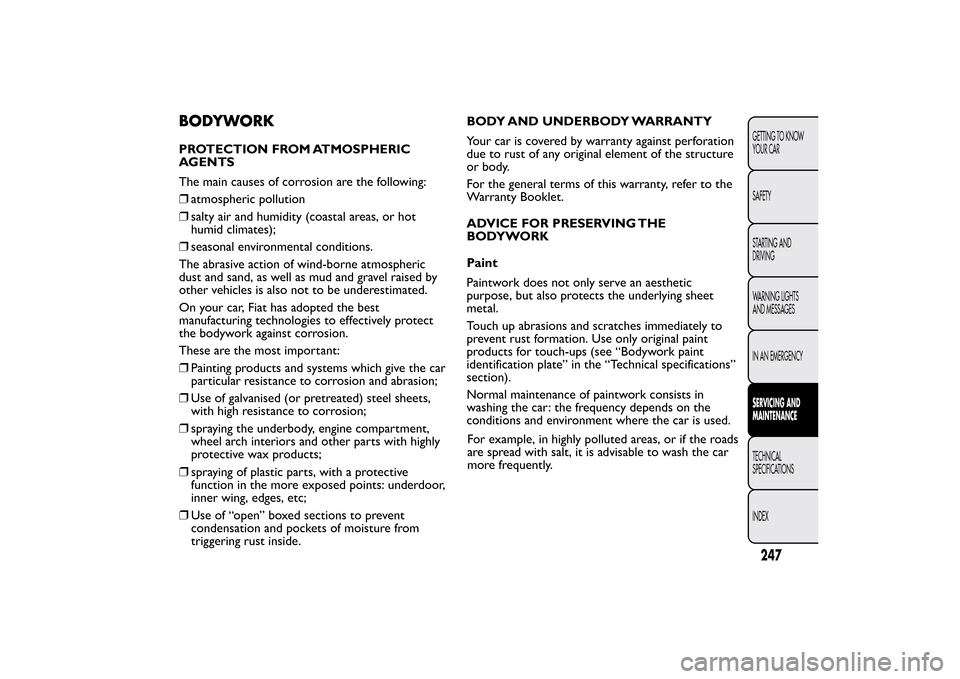
BODYWORKPROTECTION FROM ATMOSPHERIC
AGENTS
The main causes of corrosion are the following:
❒atmospheric pollution
❒salty air and humidity (coastal areas, or hot
humid climates);
❒seasonal environmental conditions.
The abrasive action of wind-borne atmospheric
dust and sand, as well as mud and gravel raised by
other vehicles is also not to be underestimated.
On your car, Fiat has adopted the best
manufacturing technologies to effectively protect
the bodywork against corrosion.
These are the most important:
❒Painting products and systems which give the car
particular resistance to corrosion and abrasion;
❒Use of galvanised (or pretreated) steel sheets,
with high resistance to corrosion;
❒spraying the underbody, engine compartment,
wheel arch interiors and other parts with highly
protective wax products;
❒spraying of plastic parts, with a protective
function in the more exposed points: underdoor,
inner wing, edges, etc;
❒Use of “open” boxed sections to prevent
condensation and pockets of moisture from
triggering rust inside.BODY AND UNDERBODY WARRANTY
Your car is covered by warranty against perforation
due to rust of any original element of the structure
or body.
For the general terms of this warranty, refer to the
Warranty Booklet.
ADVICE FOR PRESERVING THE
BODYWORK
Paint
Paintwork does not only serve an aesthetic
purpose, but also protects the underlying sheet
metal.
Touch up abrasions and scratches immediately to
prevent rust formation. Use only original paint
products for touch-ups (see “Bodywork paint
identification plate” in the “Technical specifications”
section).
Normal maintenance of paintwork consists in
washing the car: the frequency depends on the
conditions and environment where the car is used.
247GETTING TO KNOW
YOUR CAR
SAFETY
STARTING AND
DRIVING
WARNING LIGHTS
AND MESSAGES
IN AN EMERGENCYSERVICING AND
MAINTENANCETECHNICAL
SPECIFICATIONS
INDEX
For example, in highly polluted areas, or if the roads
are spread with salt, it is advisable to wash the car
more frequently.
Page 252 of 299
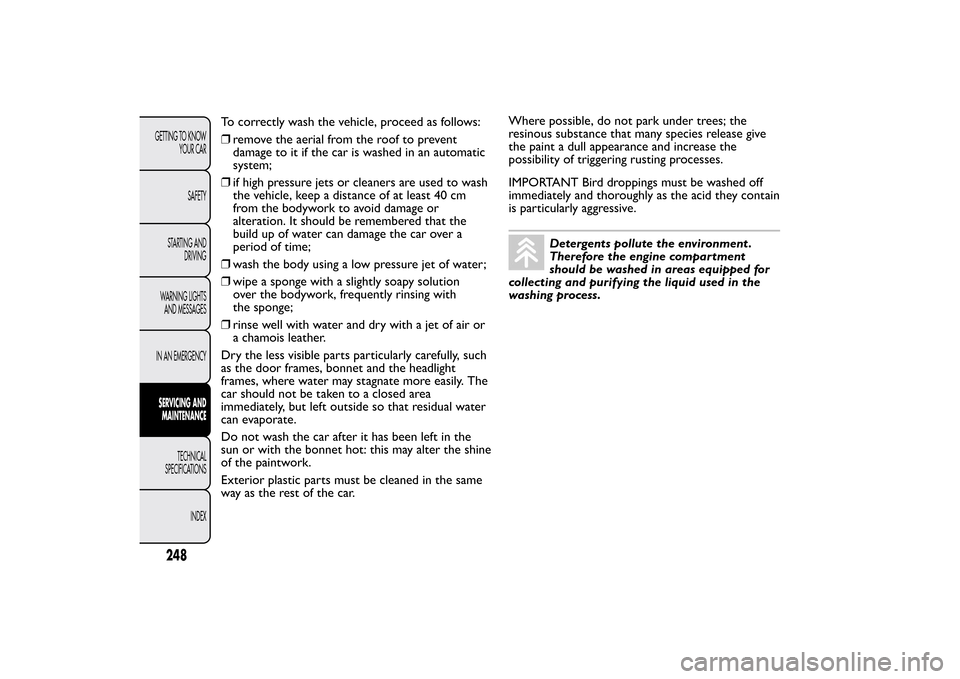
To correctly wash the vehicle, proceed as follows:
❒remove the aerial from the roof to prevent
damage to it if the car is washed in an automatic
system;
❒if high pressure jets or cleaners are used to wash
the vehicle, keep a distance of at least 40 cm
from the bodywork to avoid damage or
alteration. It should be remembered that the
build up of water can damage the car over a
period of time;
❒wash the body using a low pressure jet of water;
❒wipe a sponge with a slightly soapy solution
over the bodywork, frequently rinsing with
the sponge;
❒rinse well with water and dry with a jet of air or
a chamois leather.
Dry the less visible parts particularly carefully, such
as the door frames, bonnet and the headlight
frames, where water may stagnate more easily. The
car should not be taken to a closed area
immediately, but left outside so that residual water
can evaporate.
Do not wash the car after it has been left in the
sun or with the bonnet hot: this may alter the shine
of the paintwork.
Exterior plastic parts must be cleaned in the same
way as the rest of the car.Where possible, do not park under trees; the
resinous substance that many species release give
the paint a dull appearance and increase the
possibility of triggering rusting processes.
IMPORTANT Bird droppings must be washed off
immediately and thoroughly as the acid they contain
is particularly aggressive.
Detergents pollute the environment .
Therefore the engine compartment
should be washed in areas equipped for
collecting and purifying the liquid used in the
washing process.
248GETTING TO KNOW
YOUR CAR
SAFETY
STARTING AND
DRIVING
WARNING LIGHTS
AND MESSAGES
IN AN EMERGENCYSERVICING AND
MAINTENANCE
TECHNICAL
SPECIFICATIONS
INDEX
Page 253 of 299
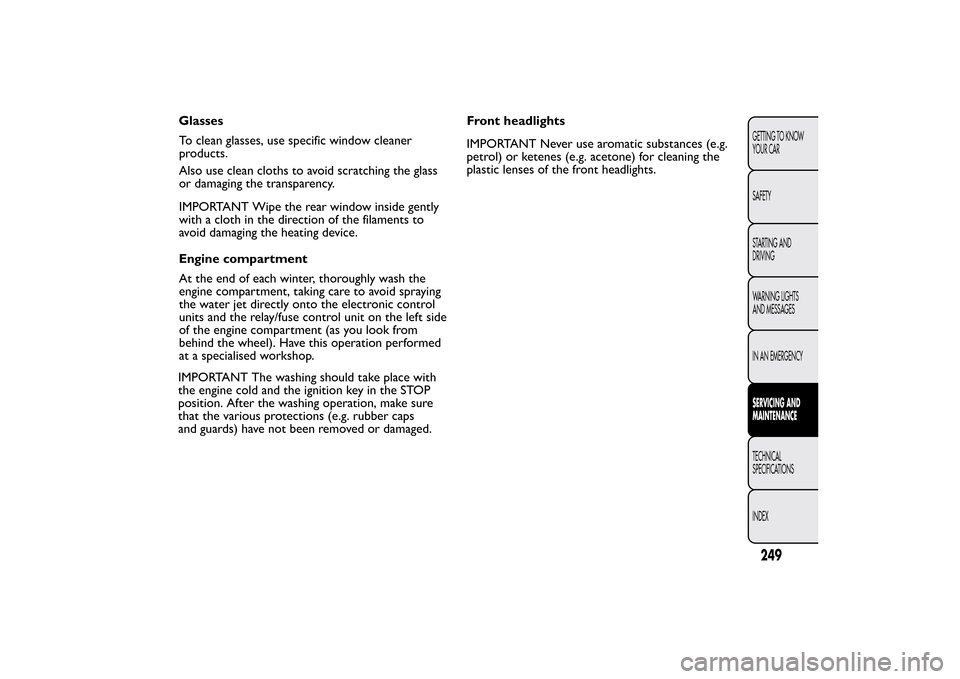
Glasses
To clean glasses, use specific window cleaner
products.
Also use clean cloths to avoid scratching the glass
or damaging the transparency.
IMPORTANT Wipe the rear window inside gently
with a cloth in the direction of the filaments to
avoid damaging the heating device.
Engine compartment
At the end of each winter, thoroughly wash the
engine compartment, taking care to avoid spraying
the water jet directly onto the electronic control
units and the relay/fuse control unit on the left side
of the engine compartment (as you look from
behind the wheel). Have this operation performed
at a specialised workshop.
IMPORTANT The washing should take place with
the engine cold and the ignition key in the STOP
position. After the washing operation, make sure
that the various protections (e.g. rubber caps
and guards) have not been removed or damaged.Front headlights
IMPORTANT Never use aromatic substances (e.g.
petrol) or ketenes (e.g. acetone) for cleaning the
plastic lenses of the front headlights.
249GETTING TO KNOW
YOUR CAR
SAFETY
STARTING AND
DRIVING
WARNING LIGHTS
AND MESSAGES
IN AN EMERGENCYSERVICING AND
MAINTENANCETECHNICAL
SPECIFICATIONS
INDEX
Page 254 of 299
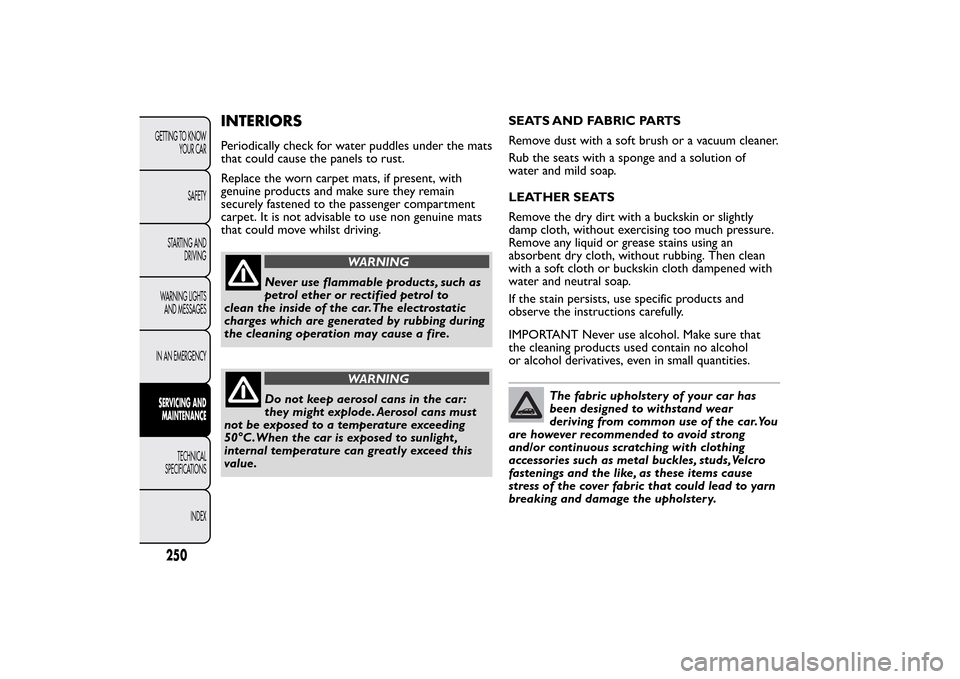
INTERIORSPeriodically check for water puddles under the mats
that could cause the panels to rust.
Replace the worn carpet mats, if present, with
genuine products and make sure they remain
securely fastened to the passenger compartment
carpet. It is not advisable to use non genuine mats
that could move whilst driving.
WARNING
Never use flammable products, such as
petrol ether or rectified petrol to
clean the inside of the car.The electrostatic
charges which are generated by rubbing during
the cleaning operation may cause a fire.
WARNING
Do not keep aerosol cans in the car:
they might explode. Aerosol cans must
not be exposed to a temperature exceeding
50°C .When the car is exposed to sunlight ,
internal temperature can greatly exceed this
value.SEATS AND FABRIC PARTS
Remove dust with a soft brush or a vacuum cleaner.
Rub the seats with a sponge and a solution of
water and mild soap.
LEATHER SEATS
Remove the dry dirt with a buckskin or slightly
damp cloth, without exercising too much pressure.
Remove any liquid or grease stains using an
absorbent dry cloth, without rubbing. Then clean
with a soft cloth or buckskin cloth dampened with
water and neutral soap.
If the stain persists, use specific products and
observe the instructions carefully.
IMPORTANT Never use alcohol. Make sure that
the cleaning products used contain no alcohol
or alcohol derivatives, even in small quantities.
The fabric upholstery of your car has
been designed to withstand wear
deriving from common use of the car.You
are however recommended to avoid strong
and/or continuous scratching with clothing
accessories such as metal buckles, studs,Velcro
fastenings and the like, as these items cause
stress of the cover fabric that could lead to yarn
breaking and damage the upholstery.
250GETTING TO KNOW
YOUR CAR
SAFETY
STARTING AND
DRIVING
WARNING LIGHTS
AND MESSAGES
IN AN EMERGENCYSERVICING AND
MAINTENANCE
TECHNICAL
SPECIFICATIONS
INDEX
Page 255 of 299
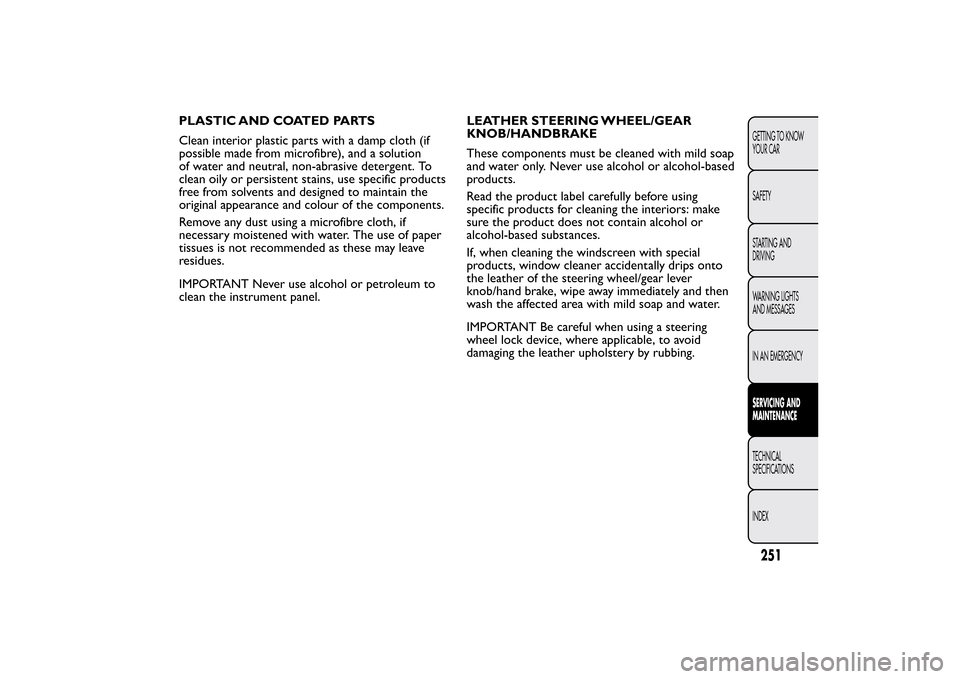
PLASTIC AND COATED PARTS
Clean interior plastic parts with a damp cloth (if
possible made from microfibre), and a solution
of water and neutral, non-abrasive detergent. To
clean oily or persistent stains, use specific products
free from solvents and designed to maintain the
original appearance and colour of the components.
Remove any dust using a microfibre cloth, if
necessary moistened with water. The use of paper
tissues is not recommended as these may leave
residues.
IMPORTANT Never use alcohol or petroleum to
clean the instrument panel.LEATHER STEERING WHEEL/GEAR
KNOB/HANDBRAKE
These components must be cleaned with mild soap
and water only. Never use alcohol or alcohol-based
products.
Read the product label carefully before using
specific products for cleaning the interiors: make
sure the product does not contain alcohol or
alcohol-based substances.
If, when cleaning the windscreen with special
products, window cleaner accidentally drips onto
the leather of the steering wheel/gear lever
knob/hand brake, wipe away immediately and then
wash the affected area with mild soap and water.
IMPORTANT Be careful when using a steering
wheel lock device, where applicable, to avoid
damaging the leather upholstery by rubbing.
251GETTING TO KNOW
YOUR CAR
SAFETY
STARTING AND
DRIVING
WARNING LIGHTS
AND MESSAGES
IN AN EMERGENCYSERVICING AND
MAINTENANCETECHNICAL
SPECIFICATIONS
INDEX
Page 256 of 299
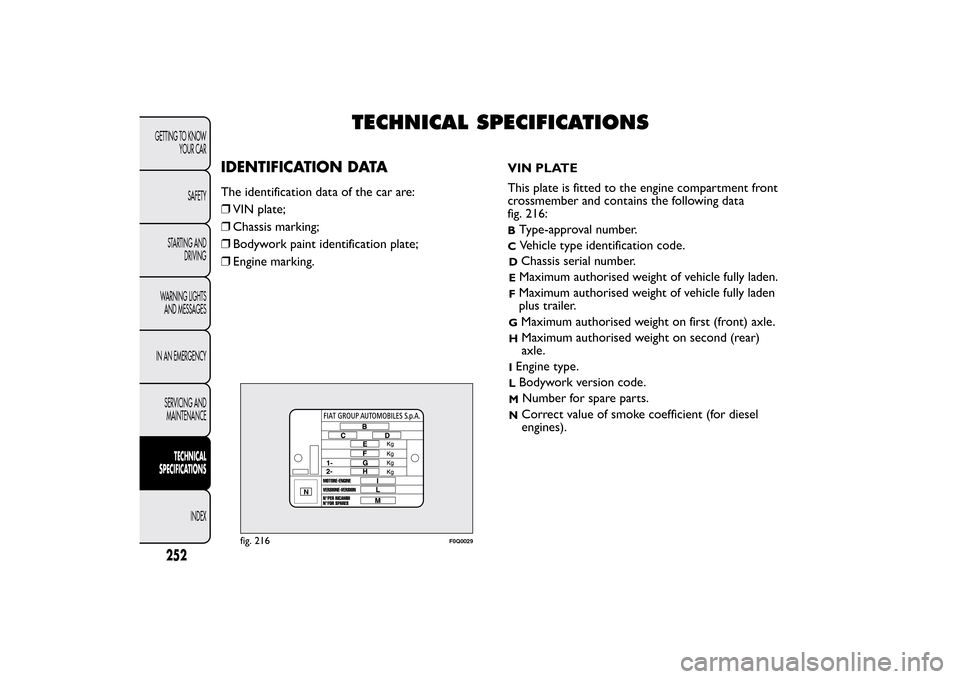
TECHNICAL SPECIFICATIONS
IDENTIFICATION DATAThe identification data of the car are:
❒VIN plate;
❒Chassis marking;
❒Bodywork paint identification plate;
❒Engine marking.VIN PLATE
This plate is fitted to the engine compartment front
crossmember and contains the following data
fig. 216:
BType-approval number.C
Vehicle type identification code.D
Chassis serial number.
EMaximum authorised weight of vehicle fully laden.FMaximum authorised weight of vehicle fully laden
plus trailer.G
Maximum authorised weight on first (front) axle.
H
Maximum authorised weight on second (rear)
axle.
IEngine type.LBodywork version code.M
Number for spare parts.
N
Correct value of smoke coefficient (for diesel
engines).
fig. 216
F0Q0029
252GETTING TO KNOW
YOUR CAR
SAFETY
STARTING AND
DRIVING
WARNING LIGHTS
AND MESSAGES
IN AN EMERGENCY
SERVICING AND
MAINTENANCE
TECHNICAL
SPECIFICATIONS
INDEX
Page 257 of 299
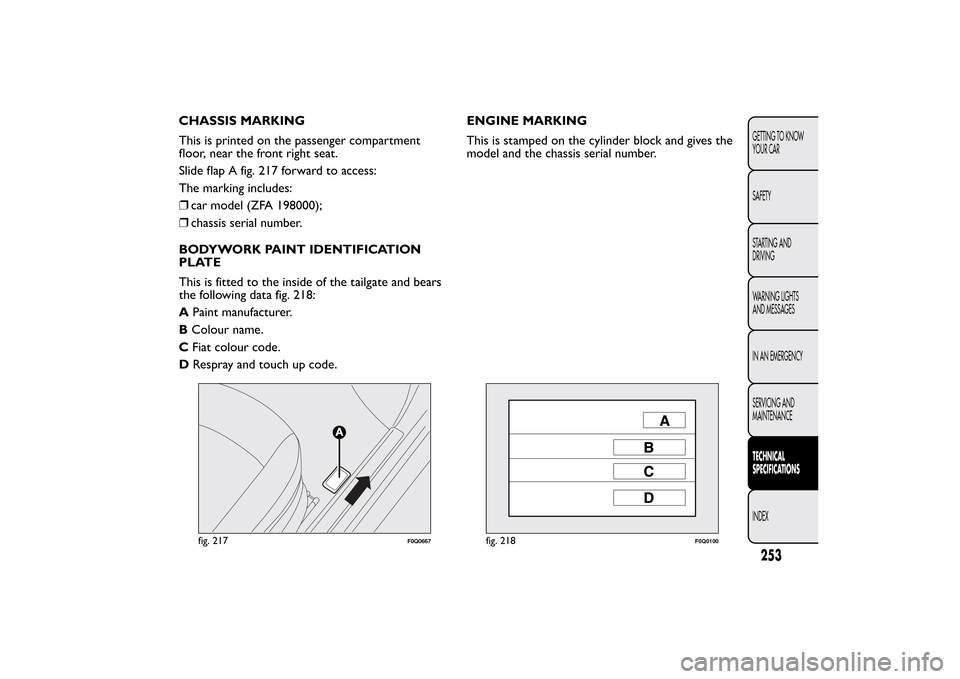
CHASSIS MARKING
This is printed on the passenger compartment
floor, near the front right seat.
Slide flap A fig. 217 forward to access:
The marking includes:
❒car model (ZFA 198000);
❒chassis serial number.
BODYWORK PAINT IDENTIFICATION
PLATE
This is fitted to the inside of the tailgate and bears
the following data fig. 218:
APaint manufacturer.
BColour name.
CFiat colour code.
DRespray and touch up code.ENGINE MARKING
This is stamped on the cylinder block and gives the
model and the chassis serial number.
fig. 217
F0Q0667
fig. 218
F0Q0100
253GETTING TO KNOW
YOUR CAR
SAFETY
STARTING AND
DRIVING
WARNING LIGHTS
AND MESSAGES
IN AN EMERGENCY
SERVICING AND
MAINTENANCETECHNICAL
SPECIFICATIONSINDEX
Page 258 of 299
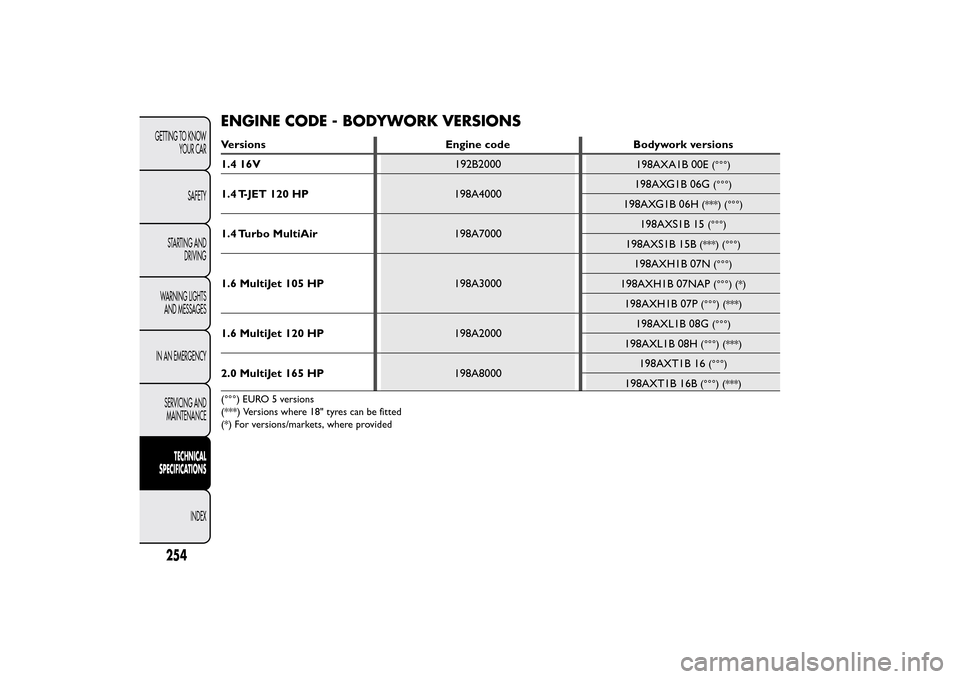
ENGINE CODE - BODYWORK VERSIONSVersions Engine code Bodywork versions
1.4 16V192B2000
198AXA1B 00E
(°°°)
1.4 T-JET 120 HP198A4000198AXG1B 06G
(°°°)
198AXG1B 06H
(***) (°°°)
1.4 Turbo MultiAir198A7000198AXS1B 15
(°°°)
198AXS1B 15B
(***) (°°°)
1.6 MultiJet 105 HP198A3000198AXH1B 07N
(°°°)
198AXH1B 07NAP
(°°°) (*)
198AXH1B 07P
(°°°) (***)
1.6 MultiJet 120 HP198A2000198AXL1B 08G
(°°°)
198AXL1B 08H
(°°°) (***)
2.0 MultiJet 165 HP198A8000198AXT1B 16
(°°°)
198AXT1B 16B
(°°°) (***)
(°°°) EURO 5 versions
(***) Versions where 18" tyres can be fitted
(*) For versions/markets, where provided
254GETTING TO KNOW
YOUR CAR
SAFETY
STARTING AND
DRIVING
WARNING LIGHTS
AND MESSAGES
IN AN EMERGENCY
SERVICING AND
MAINTENANCE
TECHNICAL
SPECIFICATIONS
INDEX
Page 259 of 299
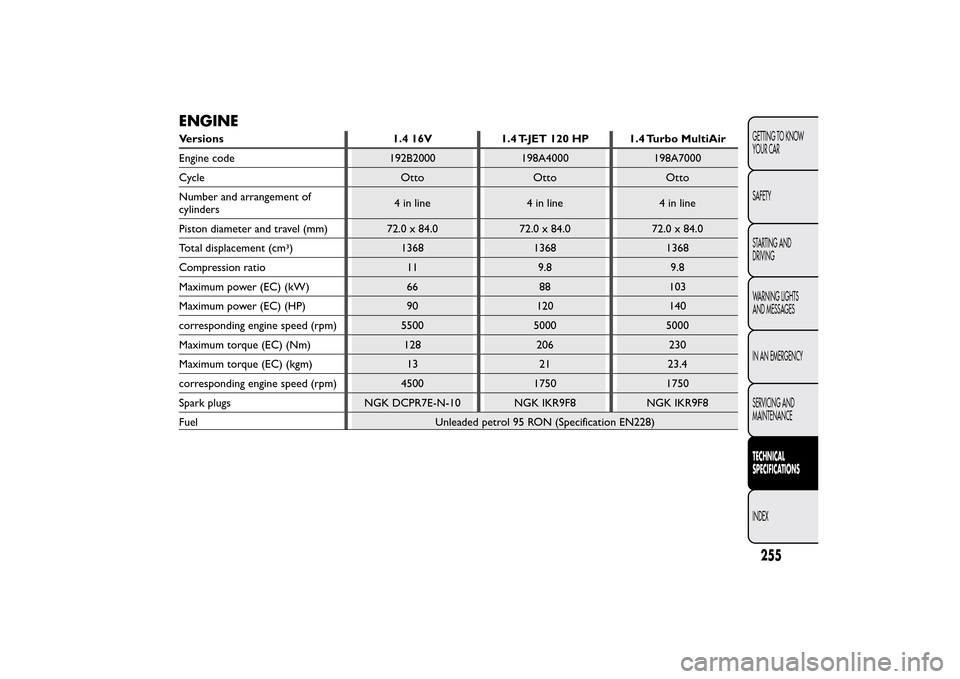
ENGINEVersions 1.4 16V 1.4 T-JET 120 HP 1.4 Turbo MultiAir
Engine code 192B2000 198A4000 198A7000
Cycle Otto Otto Otto
Number and arrangement of
cylinders4 in line 4 in line 4 in line
Piston diameter and travel (mm) 72.0 x 84.0 72.0 x 84.0 72.0 x 84.0
Total displacement (cm3) 1368 1368 1368
Compression ratio 11 9.8 9.8
Maximum power (EC) (kW) 66 88 103
Maximum power (EC) (HP) 90 120 140
corresponding engine speed (rpm) 5500 5000 5000
Maximum torque (EC) (Nm) 128 206 230
Maximum torque (EC) (kgm) 13 21 23.4
corresponding engine speed (rpm) 4500 1750 1750
Spark plugs NGK DCPR7E-N-10 NGK IKR9F8 NGK IKR9F8
Fuel Unleaded petrol 95 RON (Specification EN228)
255GETTING TO KNOW
YOUR CAR
SAFETY
STARTING AND
DRIVING
WARNING LIGHTS
AND MESSAGES
IN AN EMERGENCY
SERVICING AND
MAINTENANCETECHNICAL
SPECIFICATIONSINDEX
Page 260 of 299
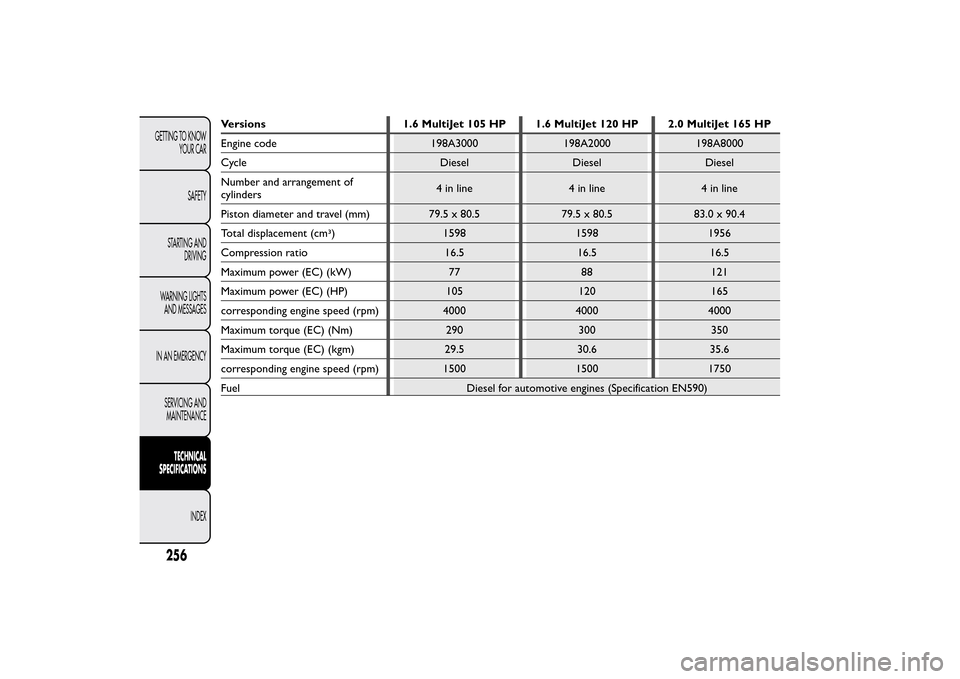
Versions 1.6 MultiJet 105 HP 1.6 MultiJet 120 HP 2.0 MultiJet 165 HP
Engine code 198A3000 198A2000 198A8000
Cycle Diesel Diesel Diesel
Number and arrangement of
cylinders4 in line 4 in line 4 in line
Piston diameter and travel (mm) 79.5 x 80.5 79.5 x 80.5 83.0 x 90.4
Total displacement (cm3) 1598 1598 1956
Compression ratio 16.5 16.5 16.5
Maximum power (EC) (kW) 77 88 121
Maximum power (EC) (HP) 105 120 165
corresponding engine speed (rpm) 4000 4000 4000
Maximum torque (EC) (Nm) 290 300 350
Maximum torque (EC) (kgm) 29.5 30.6 35.6
corresponding engine speed (rpm) 1500 1500 1750
Fuel Diesel for automotive engines (Specification EN590)
256GETTING TO KNOW
YOUR CAR
SAFETY
STARTING AND
DRIVING
WARNING LIGHTS
AND MESSAGES
IN AN EMERGENCY
SERVICING AND
MAINTENANCE
TECHNICAL
SPECIFICATIONS
INDEX